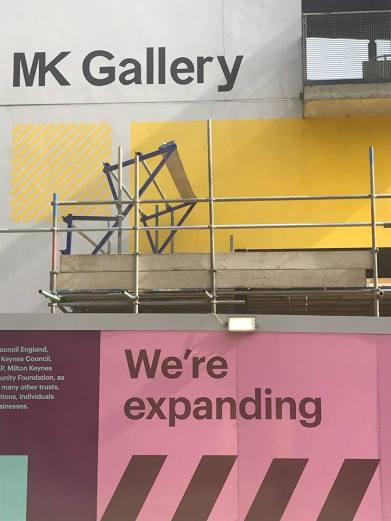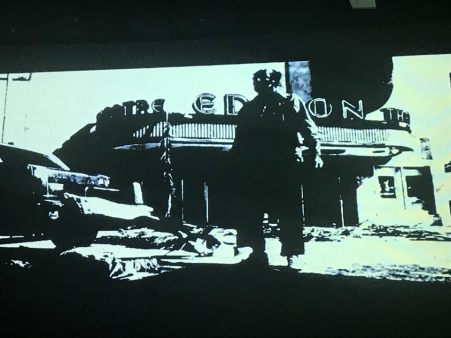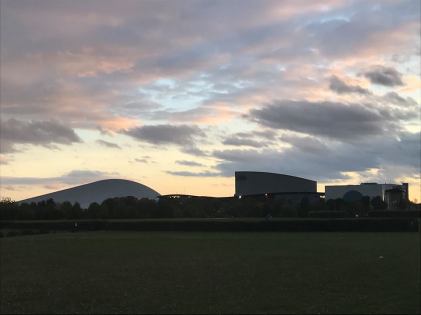
I spent last weekend at the Groundwork weekender in Milton Keynes, organised by the artist / curatorial collective, Tracing the Pathway. Groundwork set itself up as a three day event involving artists, performers, researchers, writers to respond to the environment of Milton Keynes through a carefully curated series of projects and events, and to leaven the resulting conversation with insights from other places with significant emerging art scenes, around the UK. The event itself developed from a programme of commissions that had unrolled over the summer months, from eleven commissioned artists.
Constantin Brancusi is alleged to have said once: “Nothing Grows Under the Shadow of Big Trees”. Some may say that it’s impossible for a diverse cultural scene to grow in a place such as Milton Keynes, almost equidistant underneath two very leafy, older, sun-blotting boughs in London and Birmingham. The city also has an unremittingly bad reputation with folk who’ve at best just passed through it. Art in Milton Keynes? Concrete Cows. City Centre? There isn’t one. Environment? Concrete Everywhere. Football? MK Dons- Plastic Franchise. Music? Hmm..Didn’t Cliff Richard once have a cup of tea at Watford Gap services?…and so on. You get the picture.
There was a tinge of frustration at the concrete roundabout stuff amongst the hosts last weekend, as it simply isn’t true. Milton Keynes is a very green city, with parks everywhere, and whilst it’s an advantage to have a car, it is just about walkable, if you have the time to do so. In terms of culture, it does feel as though the city is working through a crucial phase in its short history. As the photographer Richard Macer wrote in an affectionate tribute to his home town, where he was among the first generation of children to grow up:
“Someone who works at Milton Keynes council told me that it is at a critical juncture in its evolution. According to her, the town is dangerously close to becoming “another Crewe”, a place with great connectivity but a cultural desert.”
The importance of an initiative such as Groundwork, then, lies not only in helping to try and shape what may come next for visual culture in MK, but also takes place against the backdrop of an alarming decline in visits to major galleries and museums since 2014. Rather than blame ex-patrons of these institutions for “lacking engagement”, as some have sought to do, it’s better to try and understand why people seem to have fallen out of love with the spectacle of art and culture. MK Gallery is closed at present for refurbishment (and, perhaps, a re-thinking of its curatorial approach); in times when major institutions unavoidably close for such refits, formations such as Tracing the Pathway come to the fore, supported by nearly a dozen local organisations ranging from the Arts Council to cultural tourism / environmental formations such as Pedalling Culture.

Three themes were prominent in the weekend’s development; playfulness, performativity, and a visionary engagement with the material and social circumstances in which work is made. A talk by artist Cathy Wade, based on her experiences working in Digbeth in inner-city Birmingham, was very taut and relevant in that last category. She discussed the sometimes vexed relationship between art and regeneration, the expanding cycle of excitement, fulfilment and then ossification; she seemed to suggest, however, that it was the role of artists and cultural workers not to lament the lost energies of former “scenes” in now unaffordable gentrifed areas, but to be able to follow and read the smoke signals of the next area of intervention; to be able to spot at a very early stage, where artists can intervene meaningfully in a community, and how to think strategically about the consequences.

Speaking of visionary engagement, there are other examples we should spend a bit of time on; one being Sapphire Goss‘ video installation Eternity City. This is a complex, layered work installed at the Old Milton Keynes bus station (curiously and confusingly, still a working bus station).
Sapphire’s video installation grew put of a long engagement with various groups of residents in MK, and research into the history and design, and natural patterns of the place. Samplings of nature taken from around Milton Keynes are an integral layer of the final work. The work features various geometrically patterned slides based on these processes, set to the accompaniment of a beautiful ambient sound track by Rob Shields, based on sampling of local sounds. The passing hushed swoosh of rubber on tarmac is ubiquitous everywhere in MK.

The old bus station is now used as an artist studio complex, and also as a help centre for homeless people. Milton Keynes is in the grip of a Housing Crisis and it was quite shocking to see tents pitched at various points around centre:mk and the Point. Many people housed in tents, or sofa surfing around the city, do not follow the stereotypical demographics of homelessness: those suffering from addiction problems, mental health issues, or simply from the horrid combination of bad luck and bad timing, Many sleeping in tents are also doing shift work, but cannot afford local housing.

The rapidly unfolding climate change crisis caused at least in part by over a century of the internal combustion engine, calls for visionaries in a new city designed in the era of the Ford Zephyr and the Hillman Imp, and which at one time saw the spine of the city as dominated by a free monorail (which never materialised). In the present time, MK still likes to think of itself as a city of the future, conducting long term experiments into Autonomous Delivery Robots, and hoping to invest heavily and encourage local folk to take up Electric Vehicles sooner rather than later, with the dedicated MK Electric Vehicle Centre.

Although the future isn’t quite here just yet, there is a palpable sense of it being in the air; signs for autonomous pods are everywhere, and I even saw one of the small things wheezing towards one of the estates with a delivery, as I left the city on Sunday morning.
In a city where the car was meant to be the way people moved around, travelling by bike or by foot could be read as subversive. Many projects in the weekender addressed the radically different perception of MK from one of the city’s redways, nearly 300 kms worth of pathways that allow walkers and cyclists to steer clear of the main boulevards. Inevitably these become spaces for the imagination, for reflection, for dreaming; all three of these and more were found in the “ambulatory research” of Phil Smith, whose new novel The MK Myth was launched at the event; a psychogeographical, visionary response to the environment and an urgent invitation that the reader look again through the eyes of the novel’s main character; a novel that also can be read whilst walking, or suggest new ways of navigating around the city; Hayley Newman’s performative response to the redways suggested another way again of navigating and responding to the city.

A final highlight was the opening on Saturday evening of Aaron James new site-responsive AV performance, Topos. It was an epic work, lasting around 45 minutes, melding abstract patterns, folk ritual, motoring culture, and the geometric grid; an intense, blacked-out historical sweep through the differing stages of MK’s development; a triptych, from utopia to heterotopia via dystopia; dark musical references and notations called to mind something like The Hacker by Clock DVA (1982). As an experience, it was as immersive and all-ecompassing as the research and discussion that the artist has completed into place and how we make relate to it, in a multi-sensory manner, over the last three years. I wish I had had time to engage with one or two other interesting projects; Hunt and Darton‘s MK bus tour, which lasted all day on Saturday, or Katie Ellen Fields’ contribution Cover. Attention. Unearth, on the Sunday.

Earlier this year I wrote, in relation to Aberdeen’s cultural ecology, that it is much more exciting to be part of art scenes that are still emerging and being defined, rather than to participate in already well-established areas of cultural production. There’s a sense that through the exhausting processes of negotiation, discussion, mutual support, creative argument and agreed consensus, that one has the opportunity to set a new agenda, rather than try and shoehorn an individual vision into the rituals and processes established long ago by others. MK clearly is in a moment of re-shaping not only the offer of individuals, but also the infrastructure for the consumption of culture, in the city.
The whole weekend had this sense of immanence and excitement, in spades. Through conversations last weekend there may well be new collaborations with the artists of Milton Keynes to come in the future, here in Aberdeen, and I left the city with the sense that things are happening that are going to be really interesting to watch from afar. It may just be that Cathy Wade’s smoke signals are tracing the skies above MK at the moment. Go and see for yourself.
